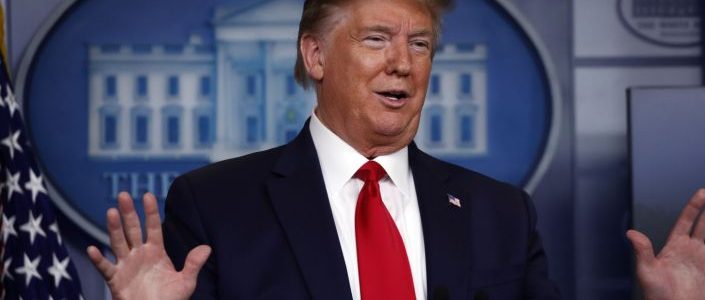
President Trump announced new federal guidelines on Thursday for the easing of social distancing orders put in place to slow the spread of the coronavirus, leaving their implementation and timing up to state governors. At first glance, the three-phase guidelines seem unlikely to alter the “new-normal” routine for many Americans.
At a White House briefing of the coronavirus task force, Trump said government experts believe that the peak of new COVID-19 cases “has been flattened.” As a result, Trump said his new guidelines “will allow governors to take a phased and deliberate approach to reopening their individual states.”

The deference to state governors comes days after Trump boasted that his “authority is total” on the question of reopening the country. But the president also made clear that he wanted a quick return to normal life.
“A national shutdown is not a sustainable long-term solution,” Trump said Thursday. “To preserve the health of our citizens, we must also preserve the health and functioning of our economy. Over the long haul, you can’t do one without the other.”

While Trump painted an optimistic picture of his administration’s efforts to curb the spread of COVID-19, his health experts — Dr. Deborah Birx and Dr. Anthony Fauci — made clear that the criteria they helped develop to guide states in their decision to lift shelter in place restrictions were stringent.
Saying that the reopening would be staggered and that states and counties would have to go through “gated criteria of 14 days of decreasing evidence of illness,” Birx outlined the tiered recommendations for loosening restrictions.
“Phase one begins with all vulnerable individuals, including those with comorbidity continuing to shelter in place, and insuring that those that first go out in public are not those that are the most vulnerable to bad outcomes in this disease,” Birx said. “And then insuring that we continue to do 6-feet [minimum] physical distancing in public spaces and continuing to avoid large gatherings and all non-essential travel.”

For states that did meet the criteria to begin phase one, a return to work could be initiated, Birx said. In order to move on to phase two, a state should demonstrate no evidence of a rebound in cases. The phase two guidelines continue to recommend that citizens avoid gatherings of 50 people or more, as well as the sheltering of vulnerable individuals, but allows for the resumption of non-essential travel.
In phase three, vulnerable individuals can resume limited public interactions, but advises that all citizens “minimize time spent in crowded environments.” Workplace restrictions would also be lifted in phase three, and gyms and bars could be reopened.
“You don’t get to phase one until you get through the gating,” Fauci clarified, adding, “If you get no rebound and satisfy the gating yet a second time, then you go to phase two. If you have no rebound and you satisfy the gating criteria for a third time, then you go into phase three.”
There was no mention of the “Opening Up America Again Congressional Group,” which the White House had announced earlier on Thursday, a panel including 97 House and Senate members, including every Republican senator except Sen. Mitt Romney of Utah, or the panel of industry and business leaders he had named at the briefing on Tuesday.
Trump said that the re-start of the nation’s economy would be uneven, depending on the medical data.
“I call it a beautiful puzzle, you have 50 pieces all different,” Trump said. At the same time, Trump said he had spoken to some governors who insisted that their states had already met the criteria for phase one.
“They will be able to go, literally, tomorrow,” Trump said of those states, without naming them.
But Fauci cautioned that the decision left to governors should not be made lightly, and that confidence in a quick return to normal remained unwarranted.
“Even if you are in phase one, two or three, it’s not OK, game over, it’s not,” Fauci said, adding, “There may be some setbacks, this is uncharted waters.”
Credit Yahoo News
